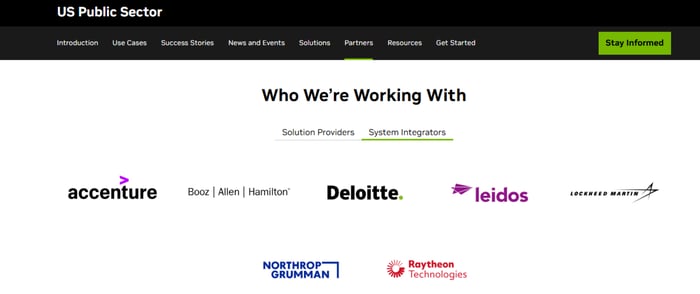Nvidia Stock Is Poised to Benefit From Rising Use of AI in Defense Systems and Global Surge in Defense Spending

Key Points
Global defense priorities are shifting to include greater spending on advanced technologies, such as artificial intelligence (AI).
These trends should benefit Nvidia, which is the dominant provider of AI chips and related technologies.
Nvidia (NASDAQ: NVDA), the leader in artificial intelligence (AI) chips and related technology, is poised to benefit from two trends in the defense industry:
1. The global surge in defense spending
Where to invest $1,000 right now? Our analyst team just revealed what they believe are the 10 best stocks to buy right now. Learn More »
2. The "teching up" of defense systems
There are many reasons to be bullish on Nvidia stock as a long-term investment -- and this is yet another one. However, this topic is significantly under-covered in the financial press, so I decided to dig in.

Image source: Getty Images.
Why the scarcity of data on Nvidia's connections to defense applications?
I think there are likely several reasons for the scarcity of information about Nvidia's connections to defense applications. First, there's little doubt that some of the uses of Nvidia's tech are classified, so there would be no press releases or management discussions of them.
Another reason likely stems from the topic of AI being used in warfare makes some folks anxious. Thus, Nvidia might shy away from publicizing defense-related news, as the company's success depends upon increasing adoption of AI.
Moreover, unlike, say, AI-powered analytics company Palantir Technologies, Nvidia has a consumer business, so it wouldn't want to risk turning off some consumers. In its fiscal first quarter, Nvidia's consumer-focused gaming business brought in $3.8 billion, accounting for 8.6% of total revenue.
Trend 1: The global surge in defense spending
Europe's and NATO's increased investments in defense
In March, Ursula von der Leyen, president of the European Commission, wrote: "And Europe is ready to massively boost its defence spending." [My emphasis.]
Then in June at the NATO (North Atlantic Treaty Organization) Summit, Alliance members "agreed to increase their annual defense spending, ultimately up to 5% of their gross domestic product" by 2035, the U.S. Department of Defense (DOD) reported.
This agreement represents a huge increase. In 2024, NATO members excluding the United States (30 European members plus Canada), on average, invested 2.02% of their GDP on defense, according to NATO. That number gets boosted to the mid-two-percentage points when we add in the U.S., as we contributed about 3.4% of our GDP.
Some defense-related stocks and defense exchange-traded funds (ETFs) are already benefiting from rising investments in defense. In the first half of 2025, Rheinmetall, Germany's largest defense contractor, experienced a 36% year-over-year surge in its defense revenue. In 2025, Rheinmetall stock has soared 189% through this writing on Aug. 19, crushing the S&P 500's (SNPINDEX: ^GSPC) 9.9% return.
The U.S. also plans to notably increase defense spending
President Donald Trump's request for a fiscal year 2026 national defense budget is $1.01 trillion, which is a 13.4% increase from fiscal year 2025's enacted level. (Our country's fiscal year begins on Oct. 1 each year.) This legislation is making its way through Congress, as of this writing on Aug. 19.
Trend 2: The "teching up" of defense spending
The second global defense spending trend is the increasing prioritization of cutting-edge technologies, such as AI; autonomous systems (which includes autonomous drones); space-based systems; and cybersecurity. (There is some overlap in these categories.)
Higher defense spending on AI will naturally benefit Nvidia, the AI chip leader
This trend will naturally benefit Nvidia because its graphics processing units (GPUs) are the dominant chips by far for processing AI workloads. This includes AI training, often done in data centers, and AI inferencing, which is increasingly done "at the edge." This means within the machine in which an AI application is deployed, such as a cellphone, a drone, or a vehicle.
President Trump's "Unleashing American Drone Dominance" executive order
In June, President Trump signed an executive order (EO) called "Unleashing American Drone Dominance," aimed at speeding up U.S. drone production. There's a section in this EO called "Delivering Drones to Our Warfighters," which should result in increased use of drones in the military.
U.S. defense giant Northrop Grumman's (NYSE: NOC) CEO Kathy Warden addressed the topic of autonomous systems -- which includes autonomous drones -- in late July on the company's Q2 earnings call: "Our investment in Beacon [a flying-mission test bed] also supports the administration's call for more next-generation autonomous systems."
Drones for a wide variety of uses are increasingly becoming autonomous, thanks to AI. This trend could benefit Nvidia, as its Jetson embedded AI computing platform can act as the "brains" of drones and other types of robots.
Venture capital is flowing into "defense tech" companies
The "teching up" of defense spending has led to a growing category of companies called "defense tech" companies. These are tech companies whose products are used in defense applications, though not necessarily exclusively.
In 2024, global venture capital (VC) funding for defense-related tech companies jumped 33% year over year to $31 billion, according to consulting giant McKinsey & Company. The biggest investment areas were AI ($12 billion), next-generation communication networks, and autonomous systems ($4 billion each).
Nvidia's involvement in defense applications
Nvidia's "U.S. Public Sector" partners

Data source: Nvidia.
Within the "system integrators" category, Nvidia's "U.S. Public Sector" website page lists that it's working with four major defense contractors (Leidos, Lockheed Martin, Northrop Grumman, and RTX's Raytheon unit) and three management consulting firms that do much government work (Accenture, Booz Allen Hamilton, and Deloitte).
The website page also contains a list of "solutions providers" that Nvidia works with. These include Dell and Hewlett Packard Enterprise. Both make computer servers that integrate Nvidia chips, so they're likely selling some of these systems to the government. The other 12 companies are privately held.
This doesn't mean that all of Nvidia's tech that's used in defense-related applications is sold to one of the partners listed in its U.S. public sector website section. These are just the entities that it's publicizing that it's directly working with.
Nvidia's partnership with Northrop Grumman seems particularly deep
My research suggests Northrop and Nvidia have a long-standing and deep relationship. Northrop's name came up more often in my research than did those of other large defense contractors.
Here's a part of a press release, titled "Northrop Grumman to Accelerate AI Innovation with Nvidia Software," released in May 2024:
Northrop Grumman ... announced today an agreement for access and use of Nvidia AI software to accelerate development of some of the most advanced systems." [Emphasis mine.]
This industry-leading agreement ... gives Northrop Grumman access to Nvidia's extensive portfolio of AI and generative AI software, its platforms, and frameworks, including Nvidia Omniverse. [Omniverse is generally used for simulation purposes.]
Indeed, this looks like an "industry-leading agreement," as Northrop termed it. Not surprisingly, the release is very general. We can probably assume that many, if not most, of those "advanced systems" it mentions are defense-related.
In June 2025, Northrop released a press release titled "Northrop Grumman Expanding Its Use of Nvidia AI Technology to Advance Solutions for Space." It reads in part:
[Northrop] is expanding its use of Nvidia technology, including adding space applications to the Nvidia Omniverse simulation platform and leveraging the Nvidia Isaac Lab framework for the training, development and deployment of artificial intelligence (AI) for cognitive spacecraft operations.
Isaac Lab is Nvidia's framework for robot learning. It would seem that Northrop plans to use Nvidia's AI tech to make certain spacecraft -- perhaps satellites? -- autonomous.
Defense tech company Mercury Systems and Nvidia have been working together for many years
Defense tech company Mercury Systems touts that it's been working with Nvidia for over 20 years. Here's a snippet from an introduction to a May 2025 Mercury video: "As a preferred partner, Mercury is bringing Nvidia's latest GPU and artificial intelligence (AI) technologies to some of the most demanding environments on Earth and beyond, revolutionizing aerospace and defense applications by instantaneously turning data into actionable insights."
Basically, what Mercury does is provide "ruggedized" versions of Nvidia's products to the defense and aerospace industries.
Nvidia's tech was used in military equipment (tanks, fighter jets) as far back as at least 2012
I don't know how long Nvidia has been involved with the defense industry, but it's been for quite some time.
I found a December 2012 Nvidia press release for a contract with DARPA (the U.S. Defense Department's research arm) that included: "Nvidia processors are used in a wide variety of embedded applications today, including automobiles made by [four higher-end auto manufacturers], aircraft including the F-22 Raptor, and U.S. Army tanks." [Emphasis mine.]
The F-22 Raptor is a stealth fighter jet of the U.S. Air Force. In 2005, it began entering service. These aircraft are still in use, but no longer produced. Lockheed Martin and Boeing were the prime contractors.
My guess is that the F-22 and the U.S. Army tanks used Nvidia's tech for digital instrument or related displays.
Solid government demand for Nvidia's GPU-equipped professional workstations and Jetson platform
In my search of government public records for request for proposals (RFPs), Nvidia's name popped up a lot. A good number of these RFPs from defense-related agencies (and other governmental agencies) included Nvidia's GPU-equipped professional workstations and its Jetson platform. This AI-powered embedded platform is used to develop autonomous drones and other robots, and makes Nvidia one of the top robotics stocks.
Nvidia's tech considered "unique" and "essential" by a Naval agency
Here's an example of the type of entry that Nvidia investors should love: In July, an agency that's part of the Navy specified that it wanted to purchase perpetual licenses for 250 Nvidia RTX Workstations and five-year support service for the 250 units.
The agency had to justify being specific with brand and product and not open to other products: "The justification outlines ... and emphasizes the urgency and uniqueness of the products, which are deemed essential for fulfilling agency needs." [Emphases mine.]
This wording suggests the requesting agency does not believe this Nvidia product has any relevant competition.
Increasing global defense budgets increasing defense spending on AI = bullish for Nvidia stock
In short, defense budgets around the world are increasing, and these budgets are increasingly prioritizing advanced technologies, including AI. Nvidia's position as the leading maker of AI-enabling chips and platforms make it well positioned to benefit from these two secular global trends.
Should you invest $1,000 in Nvidia right now?
Before you buy stock in Nvidia, consider this:
The Motley Fool Stock Advisor analyst team just identified what they believe are the 10 best stocks for investors to buy now… and Nvidia wasn’t one of them. The 10 stocks that made the cut could produce monster returns in the coming years.
Consider when Netflix made this list on December 17, 2004... if you invested $1,000 at the time of our recommendation, you’d have $650,499!* Or when Nvidia made this list on April 15, 2005... if you invested $1,000 at the time of our recommendation, you’d have $1,072,543!*
Now, it’s worth noting Stock Advisor’s total average return is 1,045% — a market-crushing outperformance compared to 182% for the S&P 500. Don’t miss out on the latest top 10 list, available when you join Stock Advisor.
*Stock Advisor returns as of August 18, 2025
Beth McKenna has positions in Nvidia. The Motley Fool has positions in and recommends Accenture Plc, Nvidia, and Palantir Technologies. The Motley Fool recommends Lockheed Martin, RTX, and Rheinmetall Ag. The Motley Fool has a disclosure policy.





